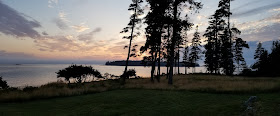Pages
▼
Saturday, August 31, 2019
Friday, August 30, 2019
Phyllis Wyeth Tribute: James Wyeth at the Farnsworth
Rockland Maine's Farnsworth Art Museum and Wyeth Center has an exhibition of Jamie Wyeth's paintings celebrating his wife Phyllis Mills Wyeth who died in January of this year. The Farnsworth website introduces it this way:
From the late 1960s onward, Phyllis Mills Wyeth (November 13, 1940 – January 14, 2019) was a muse to her husband, artist Jamie Wyeth. The selection of paintings assembled in this exhibition are a memorial tribute and reflect Phyllis Wyeth’s vibrant spirit and love of nature, horses, and her ever-present dogs.I have long felt a personal connection to Jamie Wyeth - beginning with his now iconic posthumous portrait of John F. Kennedy (for whom his wife worked); by his fascination with the work of Rockwell Kent (whose house on Monhegan Island he bought and lived in); then by occasionally spotting his boat at Georges Harbor where his mother and father lived in the summers; and by his gift to my late friend Jeff Armstrong of a painting "High Idle to Monhegan", a thank you note for ferrying his (long disabled) wife to their Monhegan home when she had missed the last ferry.
 |
| Jamie's boat headed out from a visit with family to mother Betsy on Benner Island, Georges Harbor, Maine on July 1, 2019 |
 |
| Rockwell Kent - Greenland |
Wednesday, August 28, 2019
Touring the Overlooked Islands of New York City ; New York Magazine
Touring the Overlooked Islands of New York City: More than 30 islands lie beyond the familiar borders of New York City’s five boroughs — some are tar-covered towers of trash, others offer sanctuary to migratory birds (or to the dead). Here, a visual atlas of an urban archipelago.
https://imgs.nymag.com/videos/chimney_sweeps_lede.mp4
Sunday, August 25, 2019
Windmill power
Mr President - Greenland is not for sale. But Denmark has a much better deal for you! Watch this. #dkgreen #dkpol pic.twitter.com/mlRwAVzVFg— Ida Auken (@IdaAuken) August 20, 2019
Monday, August 19, 2019
Desperate Lark
Desperate Lark is the boat of the Vaughn family - owners of Seal Cove Boatyard, Horseshoe Cove, Brooksville, Maine - on the East Penobscot Bay. Maynard Bray tells us about the 50 foot Nat Herreshoff designed and built in this article in WooodenBoat magazine. It was modified in 1939 by L. Francis Herreshoff [to whom I am partial because he designed my boat, North River 2 - a Buzzards Bay 14]. The 14 is waterline length.] In the fifties they started using length overall, which tells you less about the boat's performance than the waterline length does. But you really want LOA, LWL, draft, displacement, sail area, etc. - which you will find HERE.
 |
| North River 2 |
Friday, August 16, 2019
Sunday, August 11, 2019
Long strange trip
The essential guide to buying and consuming pot in Massachusetts
https://www.bostonglobe.com/magazine/2019/08/06/the-essential-guide-buying-and-consuming-pot-massachusetts/4dL8EBGv6N69pJM2vvgYtI/story.html
Friday, August 2, 2019
Does Church Teaching Change? | Commonweal Magazine
Does Church Teaching Change? | Commonweal Magazine: Vatican II marked a turning point, showing that appropriate change did not mean losing one’s identity but, rather, enhancing it or salvaging it from ossification
his article is an excerpt from When Bishops Meet: An Essay Comparing Trent, Vatican I, and Vatican II, published this month by Harvard University Press. Copyright © 2019 by the president and fellows of Harvard College. Used by permission. All rights reserved.
Although the documents of the early councils of the church recognized that bad customs and bad teaching had to be uprooted, which is a form of change, they most characteristically betray a sense of continuity with previous Christian teaching and practice. They called for continuation and implementation of ancient customs and ancient traditions—antiqua lex, antiqua traditio.
The documents of the medieval councils very much follow the same pattern. Although they in fact deal with the twists and turns in culture and institutional structures of their day, they lack a keen sense of discrepancy between past and present, and thus the councils never felt the necessity to address the discrepancy directly. Only with the Italian Renaissance of the fifteenth century and then the Reformation early in the next century did this ahistorical mindset receive its first serious challenges. The Council of Trent was, therefore, the first council that had to take those challenges into account.





















